|
|
JKYog e-Magazine, Issue No. 64
December, 2014
|
|
|
 |
Engage in threefold devotion through Kirtans
To progress in devotion, we must
practice it daily. Nobody can hope to become physically strong by
drinking five pounds of, or clarified butter, in just a single
day. It is by consistently eating and drinking healthy food on a
daily basis that we become strong. Similarly, spiritual progr 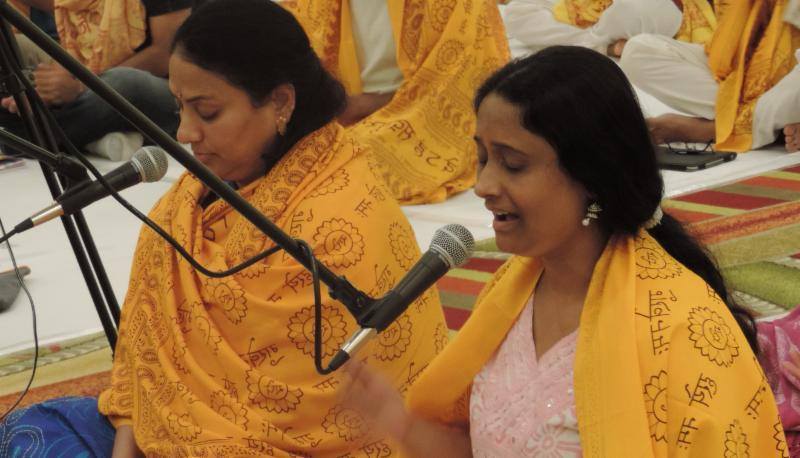 ess does not come merely by doing devotion only on special occasions. We must set up a daily practice
of bhakti. This regular practice will gradually and
systematically increase the attachment of our mind toward God. ess does not come merely by doing devotion only on special occasions. We must set up a daily practice
of bhakti. This regular practice will gradually and
systematically increase the attachment of our mind toward God.
During the time you have set aside for sadhana, you can engage in deity worship, meditation, singing kirtans
or hearing discourses. Of all the different kinds of practices,
engaging in kirtans is particularly important. It is said that chanting, hearing and remembering the names, forms, virtues and leelas of God is the simplest and most powerful form of devotion in Kaliyug, and kirtan is the combination of all three of these activities and hence it is also called Tridha bhakti, or three-fold devotion. It involves:1. Chanting the names, and descriptions of the forms, virtues, pastimes, and prayers to the Lord in melodious tunes.
2. Listening to the chantings.
3. Thinking deeply about what you are chanting, and feeling the presence of God in his Holy Name.
The glories of kirtans are also mentioned in the Scriptures:
kalerdoṣhanidhe rājannasti hyeko mahān guṇaḥ kīrtanād eva kṛiṣhṇasya muktasaṅgaḥ paraṁ vrajet (Shreemad Bhagavatam 12.3.51)
This verse from the Shreemad Bhagavatam states that Kaliyug,
the present era, is an ocean of faults - people have disturbed minds,
unsound health, they live in polluted environment, and face disturbing
situations. However, there is one very great virtue in Kaliyug. By lovingly chanting the melodious kirtans of the Lord, one can easily get liberated from material bondage.
If
someone was to ask you to sit and contemplate on Radha Krishna, you
would probably be at a loss regarding what to think. But the sweet
bhajans and kirtans written by the Saints describe
the divine names, forms, virtues, pastimes and abodes of God. When
we sing them, the mind naturally dwells upon their meaning.
Therefore kirtans are an extremely powerful way of remembering God.
As one en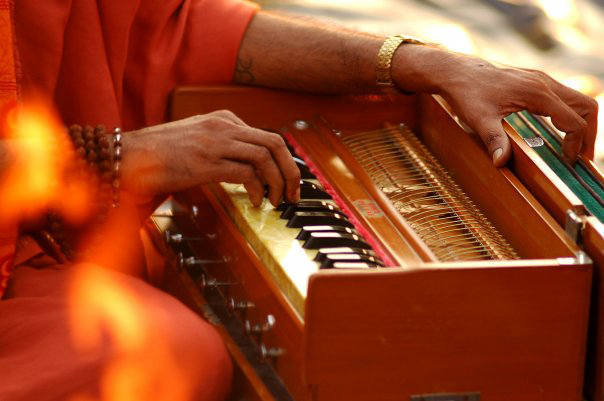 gages in this threefold devotion, there is however an important point to keep in mind. The heart and soul of kirtan lies in the involvement of the mind in devotion.
In the material world unfortunately, external behaviour takes
precedence. We say something and we mean something else. But
this behaviour does not work in the spiritual realm. God takes
note of each and every single thought in the mind; hence deception does
not work here. So when you engage in kirtan, merely
reciting with the lips or hearing with the ears does not help. You
must be genuinely engaged in the remembrance of God. This remembrance
becomes possible when we meditate on the form of God. Jagadguru
Shree Kripaluji Maharaj calls this Roopdhyan. He says: gages in this threefold devotion, there is however an important point to keep in mind. The heart and soul of kirtan lies in the involvement of the mind in devotion.
In the material world unfortunately, external behaviour takes
precedence. We say something and we mean something else. But
this behaviour does not work in the spiritual realm. God takes
note of each and every single thought in the mind; hence deception does
not work here. So when you engage in kirtan, merely
reciting with the lips or hearing with the ears does not help. You
must be genuinely engaged in the remembrance of God. This remembrance
becomes possible when we meditate on the form of God. Jagadguru
Shree Kripaluji Maharaj calls this Roopdhyan. He says:
saba sādhana janu deha sama, roopa dhyān janu prāna, khāta gīdha aru swān janu, kāmādik śhava māna (Bhakti Shatak) All the means of sadhana are like the body, while Roopdhyan
(meditation on the divine from of God) is the life-air. As a body
without life-airs is eaten by dogs and vultures, similarly sadhana without Roopdhyan is eaten by lust, greed, etc.
So if you wish to progress strongly on your spiritual path, make kirtans
a part of your daily sadhana routine. Take some out every day and
sit in a place away from material disturbances. Take help of
popular kirtans composed by Saints and experience the sweet bliss of devotion.
|
 |
 |
|
|
|
If
someone was to ask you to sit and contemplate on Radha Krishna, you
would probably be at a loss regarding what to think. But the sweet
bhajans and kirtans written by the Saints describe the divine names,
forms, virtues, pastimes and abodes of God. When we sing them, the
mind naturally dwells upon their meaning. Therefore kirtans are
an extremely powerful way of remembering God.
|
|
|
 |
 |
|
Divine Kirtans Revealed by
Jagadguru Shree Kripaluji Maharaj
Jagadguru
Shree Kripaluji Maharaj has compassionately revealed thousands of
inspiring couplets, verses, devotional songs (pads) and kirtans, for
souls practicing spirituality and striving on their path to God.
These compositions describe the divine pastimes of Radha-Krishna and
inspire spiritual aspirants to rediscover their eternal relation with
God. Everyday these kirtans provide a basis of devotion to
millions of seekers, who experience ever-increasing devotional
sentiments by engaging in sadhana bhakti as prescribed by Shree Kripaluji Maharaj.
The plethora of literature revealed
by Shree Maharajji leaves everyone amazed, as its vastness is truly
unparalleled. For the benefit of our readers, we have highlighted some
of Maharajji's most important kirtans. The books and DVDs for these kirtans are available on JKYog's gift shop. Click on this link to find more: www.jkyog.org/shop
| 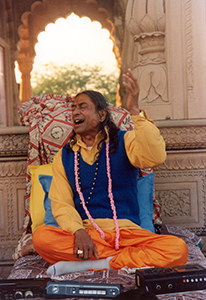 |
 |
|
|
Prema Ras Madira - English (Vol. I - III)
The
pastimes of the Divine Couple have been depicted in these 1008 padas or
devotional songs, that are divided into twenty-one madhuri's or
devotional sweetnesses in accordance with narrations in the Vedas,
Puranas and other scriptures and the writings of the Rasik Saints.
In
this miraculous book Shree Maharaj Ji succeeds in evoking intense
devotional sentiments in the reader by expertly taking him through the
various moods of devotional love, including the sweetness of meeting and
the sweetness of separation from Shree Radha Krishna. The words and
their arrangement, together with the incredibly detailed intricacy of
the descriptions of Shree Radha Krishna and their various
ornamentations, natures and behaviour are all simply breathtaking. This
book is an absolutely essential devotional item for anyone who wishes to
engage in Roopdhyan, the loving remembrance of the Supreme Divine
Couple, Shree Radha Krishna.
|
|
|
Shyama Shyam Geet
Awash with the sweetest form of transcendental bliss, Shyama Shyam Geet is a uniqu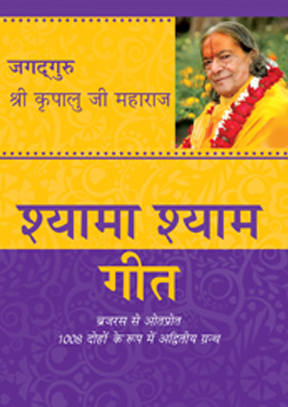 e
creation of Jagadguru Shree Kripalu Ji Maharaj. He explains that
selfless devotion to Shree Radha Krishna is the easiest and best course
of action open to any human being, regardless of cast, culture, creed
and so on. Shyama Shyam Geet contains the most intimate loving pastimes
of Shree Radha Krishna presented in the form of 1008 couplets. e
creation of Jagadguru Shree Kripalu Ji Maharaj. He explains that
selfless devotion to Shree Radha Krishna is the easiest and best course
of action open to any human being, regardless of cast, culture, creed
and so on. Shyama Shyam Geet contains the most intimate loving pastimes
of Shree Radha Krishna presented in the form of 1008 couplets.
This
beautifully presented, sweet and devotional text is something all
seekers of divine love will relish and enjoy throughout their
spiritual pursuits
|
|
|
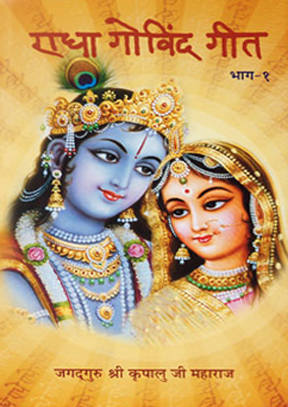 Radha Govind Geet (Vol. I - II) Radha Govind Geet (Vol. I - II)
Radha
Govind Geet is akin to an encyclopaedia of divine knowledge. Its 11,111
dohas or 'devotional couplets' published in two volumes overflow with
the essence of the philosophy of the Vedas, Shastras, Puranas and other
scriptures, revealed in a very simple lucid form. The verses are a rich
and splendid source of philosophy, devotion, grace and leela bliss of
Shree Radha Krishna in a variety of moods and sentiments, that purifies a
devotees heart and increases their thirst to attain the divine love of
Shree Radha Krishna.
|
|
|
Braj Ras Madhuri - Part 1,2 & 3
First published twenty years ago, Braj Ras Madhuri Part One contains 216 sankirtans or devotional 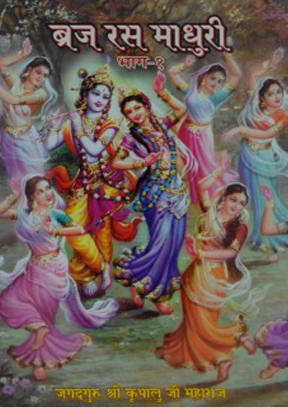 songs revealed by Jagadguru Shree Kripalu Ji Maharaj. In the true
sense, Braj Ras Madhuri Part One is an outpouring of Braj Ras. It
is a revelation of the innermost sentiments of divine love spontaneously
coming out from the heart of a Rasik Saint.
songs revealed by Jagadguru Shree Kripalu Ji Maharaj. In the true
sense, Braj Ras Madhuri Part One is an outpouring of Braj Ras. It
is a revelation of the innermost sentiments of divine love spontaneously
coming out from the heart of a Rasik Saint.
Braj
Ras Madhuri Part Two contains 134 sankirtans or devotional songs, It
contains a delightf ul array of exceptionally sweet pastimes of
Shree Radha Krishna balanced with a smaller number of philosophical
songs detailing the nature of the individual soul and its relationship
to the Supreme Soul, God.
The
last in the trilogy, Braj Ras Madhuri Part Three presently comprises of
125 sankirtans or devotional songs. Keeping in touch with the previous
two parts, Part Three presents devotional subject matter in a poetical
style, including depictions of the sweetest of loving pastimes of the
Divine Couple to warm the heart, as well as some philosophical songs to
satisfy and curb the wandering minds of aspirants.
|
|
|
Yugal Ras 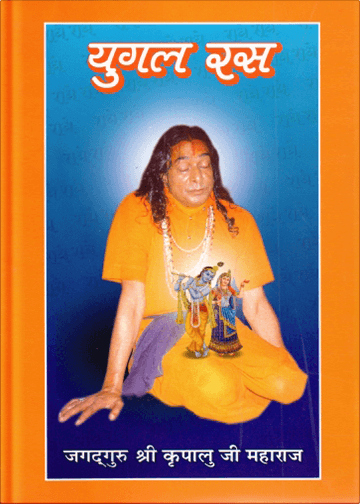
Yugal
Ras is a compilation of his 100 kirtans imbued with divine love.
Spiritual principles related to Bhaktiyog have been beautifully
described in a very simple manner so that even a common person can
assimilate the sentiments being expressed. There are kirtans that invoke
feelings of humility in the heart of the aspirant too and kirtans
describing the sweet pastimes and divine forms of the Divine Couple,
resplendently adorned with beautiful adornments.
|
|
|
Yugal Shatak 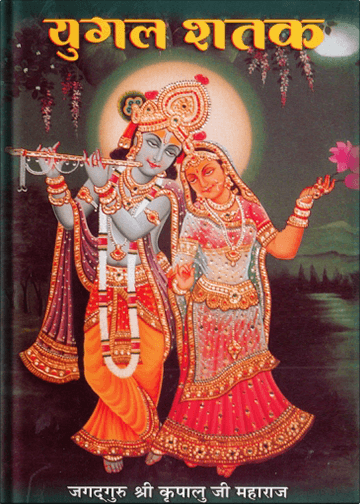
Pervading with the power to submerge the reader in the depths of the ocean of Braj Ras, this incomparable
and unparalleled masterpiece of devotional poetry by Shree Maharajji
comprises of one hundred most beautiful and blissful verses with fifty
dedicated to Shree Radha and fifty to Shree Krishna.
|
|
Bhakti Shatak
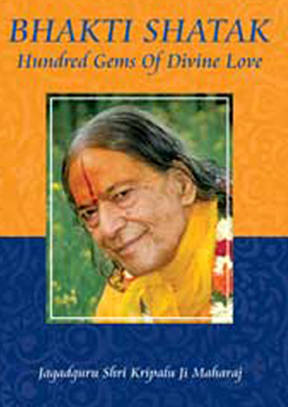
Bhakti Shatak (Hundred Gems of
Divine Love), is a clear and concise description of the complete
philosophy of the devotional path for the seeker of divine love.
These verses (with explanations)
reveal the deepest philosophy of the main scriptures of Hinduism
including the Bhagavad Gita, the Upanishads, and the Brahma Sutra, along
with the Bhagwatam and the writings of the great Rasika Saints Roop
Goswami, Sanatan Goswami and Jeev Goswami.
|
|
 |
 |
Jagadguru Kripaluji Yog is registered with Amazon Smile
|
 |
- Amazon will donate 0.5% of the price of your eligible AmazonSmile purchases to Jagadguru Kripaluji Yog whenever you shop on AmazonSmile.
- You can select a different charitable organization after signing in.
- AmazonSmile is the same Amazon you know. Same products, same prices, same service.
- Support your charitable organization by starting your shopping at
smile.amazon.com.
|
|
 |
 |
|
News & Updates
|
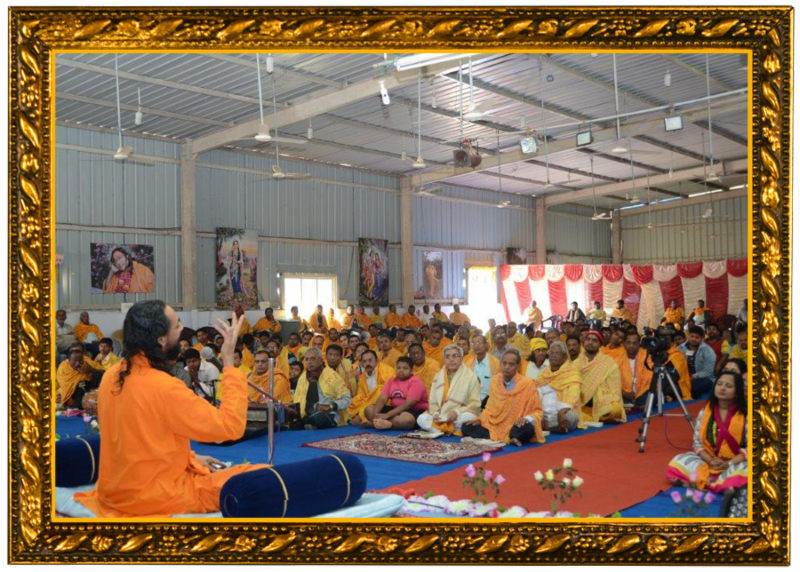
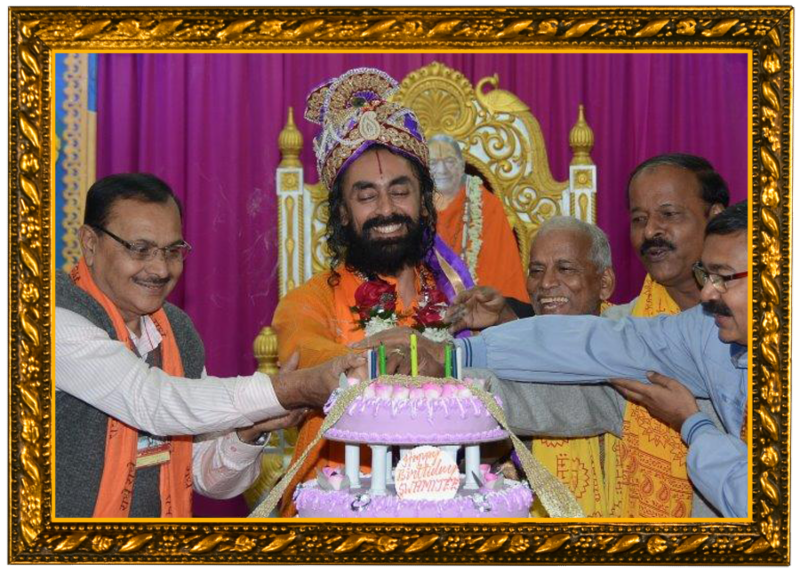
|
Sadhana Shibir at Banara, Orissa
The
four day sadhana shibir was held at JK University in Banara on 18th Dec
2014 and concluded on 21st Dec 2014. Hundreds of devotees from
different parts of Odisha gathered for the shibir which included
intensive sadhana sessions, lectures by Swamiji and Parikrama.
The
second day of sadhana shivir was flooded with joy and excitement as it
also happened to be Swamiji's birthday. On the eager request of devotees
to celebrate his birthday, Swamiji cut a cake in the sadhana hall. He
first offered the cake to beloved Maharajji and Ammaji, which was
followed by Maharajji's aarti and sweets distribution. See pictures
Swamiji
visited various centers of Gujarat in his tour of ten days. He
covered Vapi, Anand, Patan, Palanpur, Baroda, and Ahmedabad. See pictures Swamiji also conducted 7-day Ram Katha program in Berhampur. See pictures
|
| |
|
|
|
 |
|
|
by Jagadguru Shree Kripaluji Maharaj
The
spiritual government keeps a complete record of all the actions of a
person. When a person dies and takes a new birth, a portion of his
previous life's doing are given to him. Thus, we have created our destiny ourselves by actions in past births.
|
|
To start with there are three kinds of karmas: sańchit, prārabdh and kriyamāṇ. God has an account of all our karmas in endless lives. This is called sańchit karmas. At the time of birth, we are given a portion of our sańchit karmas, to enjoy or suffer in this life. This is called prārabdh karmas. The prārabdh is fixed, but within this life, we have a freedom to act, and the actions we perform are called kriyamāṇ karma. The kriyamāṇ is not pre-determined; it is in our hands, and can be changed as we wish.
We
people believe that God has listened to our prayers and has given us
worldly benefits on some occasions, but such a belief is wrong. Such
benefits were the results of good actions of our past lives. The reason
is that at the time of good sanskar our mind is normally inclined
towards the pious and devotional activities and at that moment when we
sincerely say our prayers and receive some material benefits, we think
that our prayers have been answered. Actually it is not so.
The
spiritual government keeps a complete record of all the actions of a
person. When a person dies and takes a new birth, a portion of his
previous life's doing are given to him (by the spiritual government) to
undergo its consequences. This is called fate or prārabdh or sańchit
karma. Thus the present life is simply a passing through the resulting
punishments or rewards of his past life's deeds. And the actions which
are done in the present life are called kriyamāṇ karma.
Actions can be classified as Good, Bad, Neutral and Devotional.
Ritual
deeds, all types of intellectual meditations, worshipping formalities
and sincere austerity, etc. belong to the class of good actions.The
results of good actions appear worldly happiness, and its corresponding
effect is the awakening of deep worldly ambitions in the heart of the
doer.
The outcome of bad action is physical and mental agony to
the doer, and at the same time, their corresponding results appear as an
awakening of impious or evil qualities in his mind. Thus bad actions
result in double trouble. On one side they appear as physical and mental
sufferings and on the other side they evoke evil in a person's mind,
which makes the sufferer more miserable and induces him towards more
doings.
Neutral actions are those actions which are done honestly
for making a living. These actions are not done to harm or please
anyone, so they are neither good nor bad, and are neutral in
consequences.
Devotional actions are those devotions which are
done without any worldly motive. Such devotional activities, which are
based on selfless love and surrender to God, are called devotional
actions. Devotional actions are done with an aim to purify the heart, so
they produce their effects accordingly and instantly.Devotional actions
are directly concerned with God, so their direct effect is mental
purity and their corresponding effect is the evolution of devotional
qualities of the mind.Devotional thoughts arise in humbleness, and
humbleness generally arises when there is no pride producing objects.
Moreover,
if we accept God as our omniscient well wisher, we don't need to ask
him for anything, because he knows better than us what is good for us,
and he himself will do the best. Thus we learn that devotion should be
selfless and there should not be any pray or worldly demand for God.
|
|
 |
|
Bhakti Shatak
Explained by Swami Mukundananda
Bhakti Śhatak
is one of Shree Kripaluji Maharaj's principle writings, with
hundred golden couplets of inspiring quotes, advice, and
guidance for sincere devotees seeking to firmly establish
themselves on the path of bhakti.
|

|
|
Continuing with the explanation of the verse:
deśhakāla nahiṅ niyama kachhu, nahiṅ kachhu śhiṣhṭāchār
sarala hṛidaya nahiṅ chhala kapaṭa, prema pantha balihār
In this verse, Jagadguru Shree Kripaluji Maharaj explains to us how easy it is to engage in bhakti (devotion). Bhakti
doesn't have any conditions; you can practice devotion anywhere - in a
temple or alone. You can do it even in a graveyard. It
doesn't have any rules of time that you must do bhakti only after taking
a bath or early in the morning. You can do it even if you are
sick with fever or are lying in the bed. You can still engage in bhakti,
and the only condition is that it should be done with a humble heart, a
heart full of trust and faith in God and free from deception. There
are so many stories of how simple people with simple hearts attain God
with ease. Here is a story from the Christian tradition.
There was a place of worship, a church, with the deity of Mother
Mary. People used to go there and ask Mother Mary for different
things, "Mother, please give me good food to eat, give me wealth and a
good house to live." There was an acrobat, who used to
display his gymnastic abilities to people. After his performance he
would extend his begging bowl and say, "Please give me something."
He used to work very hard all day long and yet not earn enough.
So he thought, "Everybody goes to Mother Mary to ask, let me also
go. I will not ask for much but I need two breads every day." One
fine evening, when everybody had retired for the day, he went to the
church and hid somewhere inside the church. The door was locked
from outside. He was the only person present in the church.
He cleared off some of the chairs and tables and created an empty space
to perform his acrobatics. Soon he started displaying his skills
to Mother Mary. His theory was, "I am going to ask her for
something. So let me first show my gymnastics and please her like I
do for the world. " He was a simple hearted person. He did not
think that it was merely a stone deity. He thought, "It's a divine
Mother and if it is a divine Mother then I must show my play to
her." For half an hour he showed the best performance of his life
and by the end of it he was sweating. The sound of his show from
inside the church was heard outside and people started wondering, "What
is happening inside the church today? Sometimes it seems like a
table is getting knocked or the chair is falling and sometimes a man
suddenly talks. There must be someone inside the church." They
peeped inside and saw a man jumping around. The crowd gathered to
enter the church and catch hold of the stranger. Everyone rushed
inside the church and started beating the acrobat. Fuming, the
people yelled, "How dare you do this? You have broken the property
of this place. It is such a sacred church and you have been
jumping around out here." The story says that at that very
moment there was a sudden thunderbolt and a brilliant lightening.
Mother Mary manifested herself and said, "Don't beat him. He is
my real devotee. He has faith in me. You people regularly
come to the church but merely pretend to be devotees. Whereas
today he truly believed that I am present here and showed his play to
me." Such stories in all different traditions are revealed by the
Saints who tell us that bhakti doesn't have any prerequisites of place,
time or rules. What it requires is a simple heart. The science of devotion tells us that bhakti is of two kinds. One is called vaidhi bhakti and the other is called raganuga bhakti. Vaidhi bhakti
is that which is done in accordance with the rules of the Vedas.
In this, devotion has to be performed as per the rules prescribed in the
Vedas. Whereas, in raganuga bhakti, the rules are there but they are secondary and the love for God is primary. Vaidhi bhakti is done with all the rules but the element of love is not dominant, on the other hand, there is raganuga bhakti where the rules are present but the goal of rules is to simply help us evoke our bhakti.
We don't become slaves of the rules; if the rules help us, we accept
them, if they don't help us in our devotion, we reject them. For example there is a rule: brahme muhoorte hṛiyuttiṣhṭhet
"Wake up in brahma muhurt
(auspicious time), take a bath and then engage in your devotional
practice." Suppose somebody is sick, the person has got fever and
he can't take bath in the morning. What does he do? Should he not
engage in devotion that day because he cannot have a bath? The
purpose of taking bath is that its helps you in your devotion; here
devotion is the primary activity, not the bath. In other words,
the goal is bhakti and the rules are helpers. But, we shift our focus and we make rules as the goal and bhakti as subservient to them.
|
 |
|

|
JKYog Presents
Bal-Mukund
Personality Development Classes for Children
|
|
Highlights:
· Character Building Values
· Yoga & Meditations
· Bhajans, Shlokas & Prayers
· Inspiring Stories
|
Showcase:
Bal-Mukund
welcomes all contributions of creative works from
children in different areas including poetry, moral
stories, art work, etc.
|
|
|
|
|
Bal-Mukund! Nurturing Wisdom & Vedic Knowledge
|
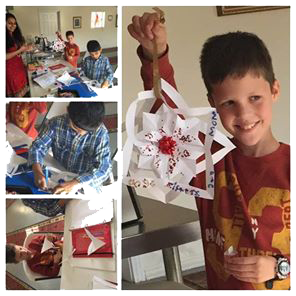 |
Imagine an environment
seeped with gems of our Vedic heritage! Imagine selfless volunteers
eager to devote their time, energy and efforts to adding love and caring
to every aspect of the learning process! Imagine the laughter and
giggles of young children as they spend time together listening to
inspiring value based stories, learning shlokas, singing bhajans, being
taught yoga asanas, pranayama, enjoying the bliss of guided meditation,
celebrating beautiful festivals, doing fun crafts, playing enjoyable
games and through it all BLOSSOMING into the BEST they can be! Now imagine your child an inseparable part of this wondrous effort we call BAL-MUKUND!
|
Envisioned
by Swami Mukundananda and inaugurated by Shree Maharajji, Bal-Mukund
is not merely a personality and character development program but, it is
an enchanting garden where the flowers are the children; the loving
gardeners, our selfless volunteers; love, knowledge and wisdom is the
water that nurtures their growth; the curriculum is the enriched soil
that feeds their soul and all this happens under glorious sunshine which
is Shree Maharajji and Swamiji's constant grace.
The
Bal-Mukund curriculum, designed for children 5 thru 15, adopts a
holistic approach to child development. It ensures that the development
of all four quotients needed for a successful, well-balanced and happy
life is encouraged in children. Spirituality, Intelligence, Adversity
and Emotional quotients are all addressed and Bal-Mukund activities
promote awareness amongst children in all these areas of development.
Through art, craft, games, storytelling, meditation, yoga and
pranayama, a multifaceted approach is adopted toward teaching the child
and ensuring that their experience at Bal-Mukund is positive,
self-fulfilling and fun. Their awareness about the rich cultural
heritage they come from is tremendously increased. They realize what
oceans of wisdom Hindu scriptures have to offer and their respect, and
love, for their Vedantic roots grows exponentially.
The Bal-Mukund program endeavors to:
* Educate young minds in the knowledge of Vedic wisdom, to lead a virtuous life
* Enthuse the spirit of giving with a service attitude
* Encourage problem solving with courage, confidence and faith
* Entertain creativity, expand power of concentration and focus
* Elevate young minds to higher levels of consciousness, and fill their hearts with love and reverence for God.
The
5 E's mentioned above coupled with the 7 'KRIPALU' values that are
encouraged in every session and through every activity, allow the
children to realize their full potential and be the best they can be. By
understanding and incorporating the values fostered by KRIPALU:
Kindness, Respect, Integrity, Perseverance, Accountability, Love for God
and Unassuming the child's personality blossoms. Swamiji resounds an
eternal truth in his statement that, "Just as the acorn carries the
potential of becoming an oak tree, children carry in them infinite
potential for future greatness." Bal-Mukund inspires them to reach for
greater heights by harnessing that potential.
Bal-Mukund currently has 11 active centers in the US, Singapore and Dubai. Centers are also spread in various cities in India.
COME EXPLORE A WORLD WHERE LEARNING IS ALWAYS FUN!
|
|
|
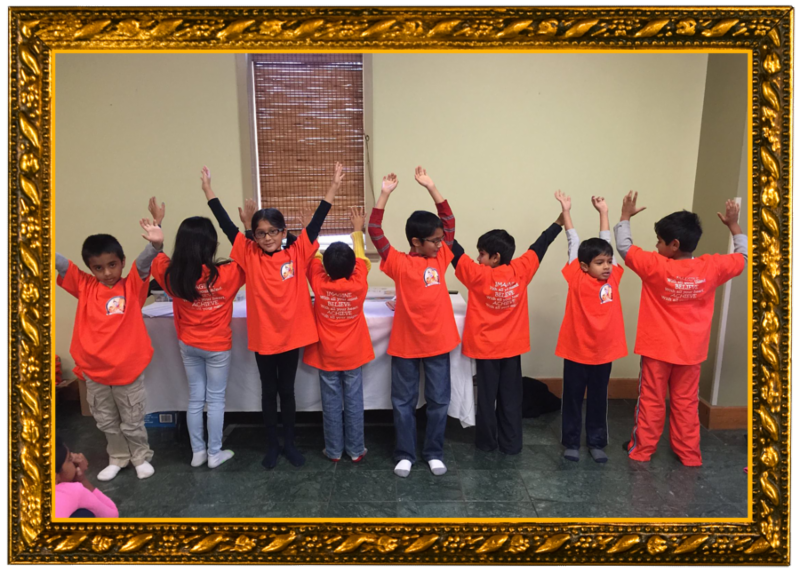
NC Center
|
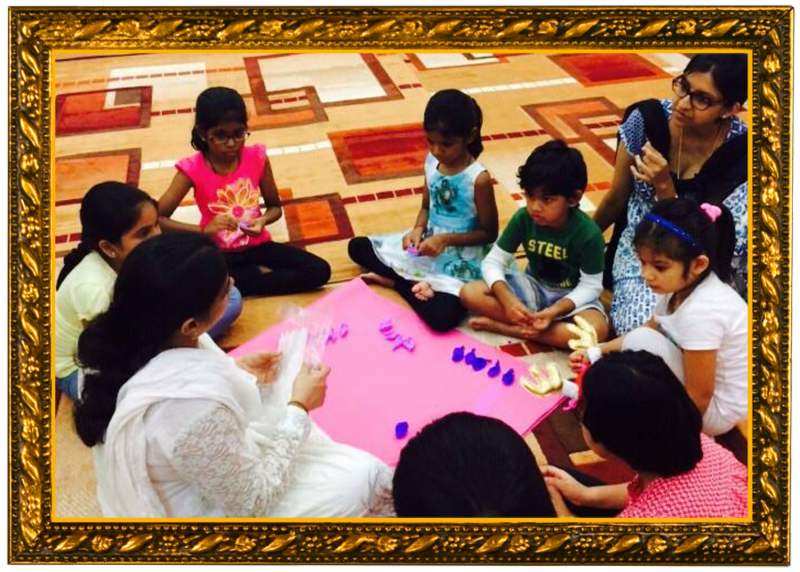
Singapore Center
|

Denver Center
|
|
|
|
|
 |
|
| 
Ingredients:
2 cups of whole wheat
1 cup of unbleached all-purpose flour
1.5 cups of sugar
2 tsp of baking soda
1 cup oil
1 cup milk
1/2 cup of water
2 mangoes (Alphonso) cut into small pieces (1 more if using for decoration)
1/2 cup walnuts
Method:
Heat oven to 350 degrees.
Spray 9x13 pan with cooking spray or rub with cooking oil and dust with flour.
Sift
flour, baking soda into bowl. Add sugar, mango and oil and stir
well. Add water and milk to the mixture and mix well.
Pour into 9x13 baking pan.
Topping:
Decorate with mango slices or walnuts and powdered sugar.
Gently place cake in heated oven. Cook for 40 minutes or until tooth pick comes out clean.
|
|
Contact us
|
The Editor JKYog: XVII/3305, 1st Floor, Ranjit Nagar
(Near PUSA), New Delhi - 110008, India
|
7405 Stoney Point Dr, Plano
TX 75025, USA
|
|
|
|
|
|